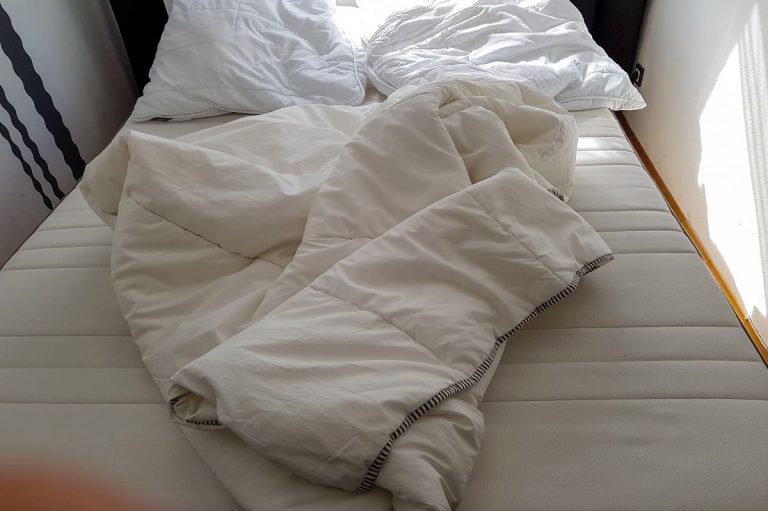Sciatica has become a rather common condition. It is generally known as a disease of the sciatic nerve, herniated disc, and pain in the lower back and usually only one leg. In 90% of all cases, sciatica is caused by a herniated or slipped disc, which is then compressing the sciatic nerve. This can happen to anyone, however, people who lead a sedentary lifestyle, do strenuous physical activity, smoke, drink, and experience mental stress are mostly at risk for sciatica.
But, none of these risks has to be a sciatica trigger. Sciatica seems to be able to flare up in basically anyone. So, what’s the deal with that? What and why does trigger sciatica and cause such pain? Well, in the following paragraphs we’ll try to find out. So, let’s get started!
What Are Common Sciatica Causes?
Sciatica can be a result of various factors and conditions. Even though the majority of the cases are caused by a herniated or slipped disc, it seems that sciatica can be a result of several underlying issues. To understand this, we’ll have to take a look at the anatomy and function of the spinal column.
Spinal Column Explained – The Primary Causes Of Sciatica
Now, the spinal column consists of three main parts, which are;
- Spinal nerves and nerve roots,
- Vertebra, or individual spinal bones which protect the underlying, spinal nerves,
- Spinal discs, also known as rubbery pads between the spinal bones. There are 23 spinal discs in a spinal column.
Now, considering that the main cause of sciatica is a herniated or slipped disc, we have to focus on the spinal discs in the spinal column. These discs are made of cartilage and act as padding between each of the spinal bones. Thanks to the spinal discs, the spine is flexible and can move or bend. However, due to a set of circumstances, spinal discs can change their position or be caused to slip.
When this happens, the nerves that the disc initially protect become irritated, worn out, and compressed. This additional pressure on the nerves is not normal, so it causes pain, which moves from the lower back to the back of the thigh and eventually to the foot and toes. As a result, people start experiencing back and leg pain, or sciatica.
Other Factors And Conditions – The Secondary Causes Of Sciatica
Even though the herniated disc is the most common cause of sciatica, there can be numerous other conditions that can result in sciatica as well. Let’s take a look at some of them;
Spinal infection – spinal infection can affect the spinal column, the neck, mid-back, or the lower back. The infection usually travels to other parts of the body. In the case of sciatica, the infection radiates in the lower back and moves to the leg.
Lumbar spinal stenosis – this is a condition where there is a narrowing of the spinal canal in the lower part of the spine or lower back. This narrowing puts additional pressure on the spinal cord and the nerves, resulting in conditions like sciatica.
Spinal tumor – the tumor appears in the spine. As a result, it compresses and puts pressure on the root of the nerves, or the sciatic nerve to be specific. This causes nerve root irritation and eventually painful condition known as sciatica.
Cauda Equina syndrome – this is a condition that appears as a result of nerve damage. The damaged nerves are often below the spinal cord, and it can be very serious. Therefore, such a condition requires immediate medical attention.
Degenerative disc disease – this is a condition where the discs between spinal bones start to deteriorate. As a result, a radiating pain occurs that moves towards the leg, and is a symptom of sciatica.
Spondylolisthesis – this condition is a result of the pinching and irritating of the lumbar nerve root. This happens because the spinal disc slips forward, over the spinal bone, pinches the nerve root, and causes pain.
Pregnancy – in pregnancy, as the baby is growing, there is more pressure on the sciatic nerve. As a result, women can experience nerve inflammation, irritation, and pain. This can evolve into sciatica if the pain becomes radiating in the lower back and moves down the legs.
But, What Makes Sciatica Flare-Up?
Even though there are some risk factors and conditions that can contribute to the occurrence of sciatica, it can still appear in anyone. But, what triggers sciatica, you may ask. Well, here are some of the main causes or triggers you should be aware of;
1. Stress
Emotional stress is never a good sign. It is known to affect the immune system and enable various diseases to occur, including back pain conditions and sciatica. Emotional stress can be a serious trigger, because with the increase of stress, the less the brain takes care of the nerves in our body. That would explain the sciatic nerve irritation and wear out, and eventually, the pain. The nerve doesn’t receive enough oxygen due to the high-stress levels, so it starts causing problems. Alongside the lower back and leg pain, it can result in overall fatigue, weakness, and other weird, almost flu-like sensations.
Tip: Always make sure to get enough time for yourself. It is essential you get to relax and take care of yourself at the end of the day. Leave the work-related worries at work, and try to focus on the things that matter; you, your family, and your friends. Also, make sure to stay active, eat well, and get enough restful sleep. All of this will help you lower the stress levels, improve mental health, and eventually the physical health.
2. Poor Posture
It is bad enough that we have to spend hours and hours sitting in front of our computers at work, usually in a bad posture. So, why contributing to the problem by keeping the bad posture even outside of the office chair. Poor posture can lead to the development of herniated disc, which can lead to sciatica. Sciatica can occur in people who have poor walking posture and poor sitting posture. So, it is essential to avoid the aggravation of sciatica symptoms by correcting the way we sit and walk and always remember to straighten our back.
Tip: Always try to keep your back in a neutral position, and your head positioned on the top of your spine. If you feel like this is hard for you, maybe your back muscles have weakened over time. This can be easily solved with some back muscle building and training. Not to mention that these exercises can help relieve sciatica pressure and pain.
3. Obesity
Obesity or excessive weight put incredible pressure on the spine. The more one weighs, the more pressure they put on the spinal bones, discs, and nerves as well. Obesity can result in chronic back pain, and it can affect the flexibility and strength of your spine and back muscles. Therefore, it is essential to always try and keep the weight under control, regardless of how difficult it can be. Physical activity and a proper, nutritional diet are the best ways to keep the weight under control or to lose weight.
Tip: Before you introduce any nutritional or activity changes, make sure to consult with your doctor, a nutritionist, or an orthopedic specialist. This way you will lose weight, keep it under control and avoid possible back injury or worsening of sciatica symptoms in the meantime.
4. Excess Sitting
Prolonged sitting can cause sciatica to flare up. Regardless of whether you’re sitting at the office, on a plane, or anywhere else, sitting for a long period can affect your back badly. Sitting, especially in a poor position, can put additional stress on the spinal discs and the nerve roots, causing irritation and pinching of the nerves. That is why it is essential to stay physically active, even after a long day at the office or after a long flight.
Tip: When at the office, make sure to stand up to stretch or take a short walk to the bathroom every hour or so. This way your back and spine will be engaged in movement and won’t feel the pressure of constant sitting. And, when you are sitting, try to keep a proper posture; your back should be in a neutral position and your head should be above the spine, not lowered towards the front.
5. High Heels
High heels can be terrible for our bodies. Women all around the world experience pain their feet, legs, and lower back pain after wearing high heels for a few hours. This happens because when on heels, you’re constantly flexing your body, forcing it to stay upright. This can create excess pressure on the thighs and the lower back, and further on the spinal discs and sciatic nerve. The nerve becomes irritated and stretched unnaturally, which results in pain, and possibly sciatica.
Tip: If you want to wear high heels, make sure to wear ones that are cushioned. This means they should have a cushioned sole and overall be shaped to fit the feet properly and support the arches. If you wear such heels, you can avoid back and feet pain, and ultimately, conditions like sciatica.
How To Avoid Sciatica Triggers?
- Regular physical activity – staying active can help you on so many levels. Exercise and regular physical activity can help you control or lose weight, strengthen your back muscles, and correct your posture. All of this can help you avoid back pain and conditions like sciatica. If you don’t like strenuous workouts, feel free to try yoga, pilates, Tai Chi, and similar workouts. These are usually low impact for the back, but overall are very effective.
- Posture correction – as mentioned before, poor posture can be one of the main sciatica triggers. So, make sure to constantly correct your posture by sitting in a neutral position and aligning your head, neck, and spine while sitting or walking. Moreover, you can even opt for posture correctors or lumbar back support to ensure you’re sitting and holding your back properly.
- Stress relief – emotional stress, negativity, anxiety, and depression can all contribute to the development of sciatica. So, make sure to relax regularly and take care of your mental health. Try to avoid stress and learn how to deal with it when you cannot avoid it. We recommend you try meditation, taking long walks in nature, listening to calming music, reading, or even painting. Go for a swim, make your favorite cake, and relax with friends over some memorable laughs. All of this will help you feel better and avoid conditions like sciatica.
- Shoe change – for women especially, changing shoes can fix so many back problems. Instead of wearing high heels every day, we recommend you sometimes opt for flat shoes or lower heels. Remember; the higher the heel, the more pressure onto the sciatic nerve! So, try out some flats that fit your style, toning shoes, or lower heels.
Final Thoughts
Sciatica is a rather tricky condition. We hope that our insight into the causes and triggers of this condition helped you figure out how to prevent or deal with sciatica. For more information, always make sure to contact your doctor, especially before you start introducing changes to your diet and training program. And, of course, always try to lead a healthy lifestyle, eat healthy food, and stay physically active. We wish you good luck, and may sciatica stay away for good!
More Resources Related to Sciatica:





